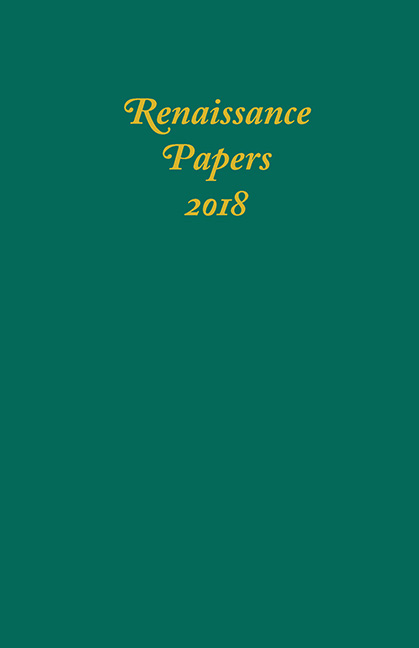Book contents
- Frontmatter
- Contents
- Renaissance Papers
- “One Little Room, An Everywhere”: Staging Silence in London's Blackfriars and Shakespeare's Henry VIII
- “What they are yet I know not”: Speech, Silence, and Meaning in King Lear
- Shakespearean Epiphany
- Between the “triple pillar” and “mutual pair”: Love, Friendship, and Social Networks in Antony and Cleopatra
- “Beauty Changed to Ugly Whoredom”: Analyzing the Mermaid Figure in The Changeling
- Imagining the Other in a Cuzco Defense of the Eucharist
- A Critique of Poor Reading: Antissia's Madness in The Countess of Montgomery's Urania
- “Thou thyself likewise art lyttle made”: Spenser, Catullus, and the Aesthetics of “smale poemes”
- The ordo salutis: Sacred Circularities in John Donne's “Good Friday 1613. Riding Westward”
- “Broken-Backed” Texts: Meritocracy and Misogyny in Ben Jonson's The Forrest
Imagining the Other in a Cuzco Defense of the Eucharist
Published online by Cambridge University Press: 21 March 2020
- Frontmatter
- Contents
- Renaissance Papers
- “One Little Room, An Everywhere”: Staging Silence in London's Blackfriars and Shakespeare's Henry VIII
- “What they are yet I know not”: Speech, Silence, and Meaning in King Lear
- Shakespearean Epiphany
- Between the “triple pillar” and “mutual pair”: Love, Friendship, and Social Networks in Antony and Cleopatra
- “Beauty Changed to Ugly Whoredom”: Analyzing the Mermaid Figure in The Changeling
- Imagining the Other in a Cuzco Defense of the Eucharist
- A Critique of Poor Reading: Antissia's Madness in The Countess of Montgomery's Urania
- “Thou thyself likewise art lyttle made”: Spenser, Catullus, and the Aesthetics of “smale poemes”
- The ordo salutis: Sacred Circularities in John Donne's “Good Friday 1613. Riding Westward”
- “Broken-Backed” Texts: Meritocracy and Misogyny in Ben Jonson's The Forrest
Summary
THE Mint Museum in Charlotte, North Carolina possesses a fascinating late seventeenth- to early eighteenth-century painting by the Cuzco school of painting known as the Defense of the Sacrament or the Defense of the Eucharist as the subject is also known and will be subsequently referred to in this essay. The Mint's Defense of the Eucharist (fig. 1) represents the king of Spain, possibly Charles II (r. 1665–1700), and Muslims beholding the Eucharist, and is intended to promote the image of the Spanish monarch as a defender of the Catholic faith. A soldier sporting a feathered helmet protects the king. A lion and orb appear underfoot as symbols of the monarch's power. Brandishing his sword, the king defends the Eucharist, the blessed bread wafer, ensconced in a jeweled, gold monstrance, from three Turks who unsuccessfully try to topple the structure with a meager ribbon. Presiding over this event, two coats-of-arms, presumably the king’s, flank an image of Christ as Pantocrator, or ruler of the universe, at the top and center of the composition.
An overlooked painting in the complicated history of viceregal Peruvian art, and a significant example of its kind, the Mint's Defense of the Eucharist makes a bold statement about the processes of evangelization and acculturation that unfolded with the Spanish colonization of the Andes.1 In all likelihood painted by an Amerindian artist, this image envisions the complex relationships among art, politics, religion, and rhetoric in viceregal Peru. It visualizes the exertion of European cultural control over non-European peoples and underscores the power of the Iberian crown to maintain religious homogeneity. It poignantly draws parallels between Muslim communities on the continent, and, by extension, Amerindian societies in the Americas. The painting, I suggest, connotes the othering of Morisco, Spanish Muslims who converted to Christianity, and Amerindian populations under Iberian imperial rule across two continents.
The Defense of the Eucharist as a Proto-Orientalist Image
The Mint's Defense of the Eucharist is representative of a larger group of paintings that represent the monarch's piety and his defense of Catholicism against both heresy and idolatry. Images of Muslims, namely in the guise of Turks, which circulated in early modern European prints, might have made their way to South America. European prints of both Turkish men and women adhered to proto- Orientalist conventions of representation.
- Type
- Chapter
- Information
- Renaissance Papers 2018 , pp. 67 - 92Publisher: Boydell & BrewerPrint publication year: 2019



